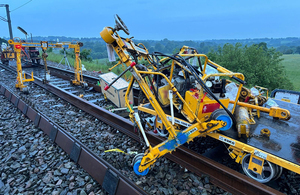Report 07/2025: Runaway of a trolley and subsequent collision at North Rode
RAIB has today released its report into the runaway of a trolley and subsequent collision at North Rode, Cheshire, 26 May 2024.

The trolley and rail-moving equipment following the collision (courtesy of Rhomberg Sersa Rail Group).
Summary
At around 05:00 on Sunday 26 May 2024, a track trolley ran away downhill towards a group of track workers at North Rode, Cheshire. A site supervisor and a controller of site safety saw the trolley approaching at around 20 mph (32 km/h) and shouted a warning which provided enough time for staff in the site of work to get clear of the track. The trolley then collided with a piece of equipment within the site of work. No one was hurt in the accident, but the trolley and work equipment were damaged.
The trolley was being used within a possession to transport equipment from a railway access point to the site of work. This section of track is on an average downhill gradient of 1 in 176.
The runaway was caused by the trolley becoming unbraked while it was on a downhill gradient after the operator had intentionally defeated the ‘failsafe’ function of the trolley’s braking system. The design of the trolley made it possible to do this and the operator was aware that it was possible to do so. The ergonomics of the trolley brake system made it tiring to use, potentially encouraging the operator to defeat the brakes. The operator was also unaware that there was a risk of the trolley running away at this location.
RAIB identified two underlying factors to the accident. These were that the product acceptance process employed by Network Rail did not manage the risks incurred by this design of trolley. A lack of clarity in site leadership roles also led to risks not being effectively managed. A further probable underlying factor was that the defeating of the braking system on this type of trolley is a known issue, but no effective action had been taken to eliminate the practice.
Recommendations
As a result of its investigation, RAIB has made two recommendations, both addressed to Network Rail. The first recommends that Network Rail, in conjunction with the Rail Safety and Standards Board and the M&EE Networking Group, reduces the likelihood of the failsafe brakes on trolleys of the type involved in this accident being modified by operators and rendered ineffective. With consideration of modern ergonomic practices and the product acceptance process, they should identify and implement control measures to prevent trolley misuse. The second recommendation aims to improve the implementation of safety learning resulting from accident and incident investigations.
Two learning points have been identified. The first reinforces the importance of staff not rendering the braking system ineffective when working with trolleys of this type. The second concerns the importance of controllers of site safety accompanying work groups to personally observe and advise them.
Notes to editors
-
The sole purpose of RAIB investigations is to prevent future accidents and incidents and improve railway safety. RAIB does not establish blame, liability or carry out prosecutions.
-
RAIB operates, as far as possible, in an open and transparent manner. While our investigations are completely independent of the railway industry, we do maintain close liaison with railway companies and if we discover matters that may affect the safety of the railway, we make sure that information about them is circulated to the right people as soon as possible, and certainly long before publication of our final report.
-
For media enquiries, please call 01932 440015.